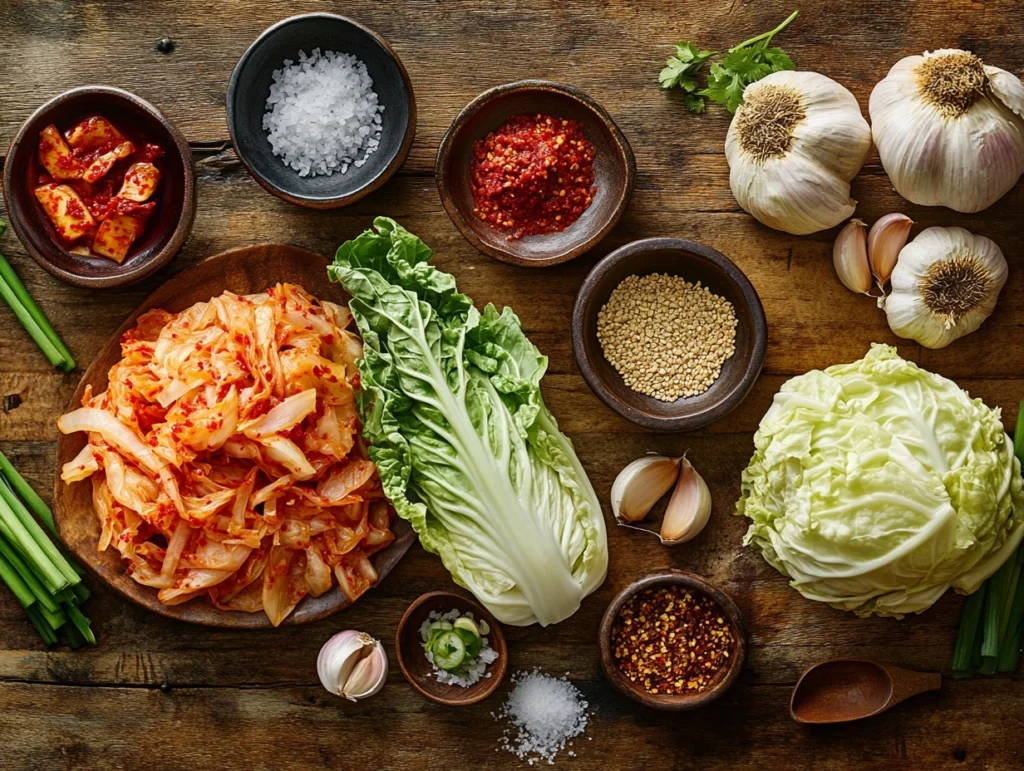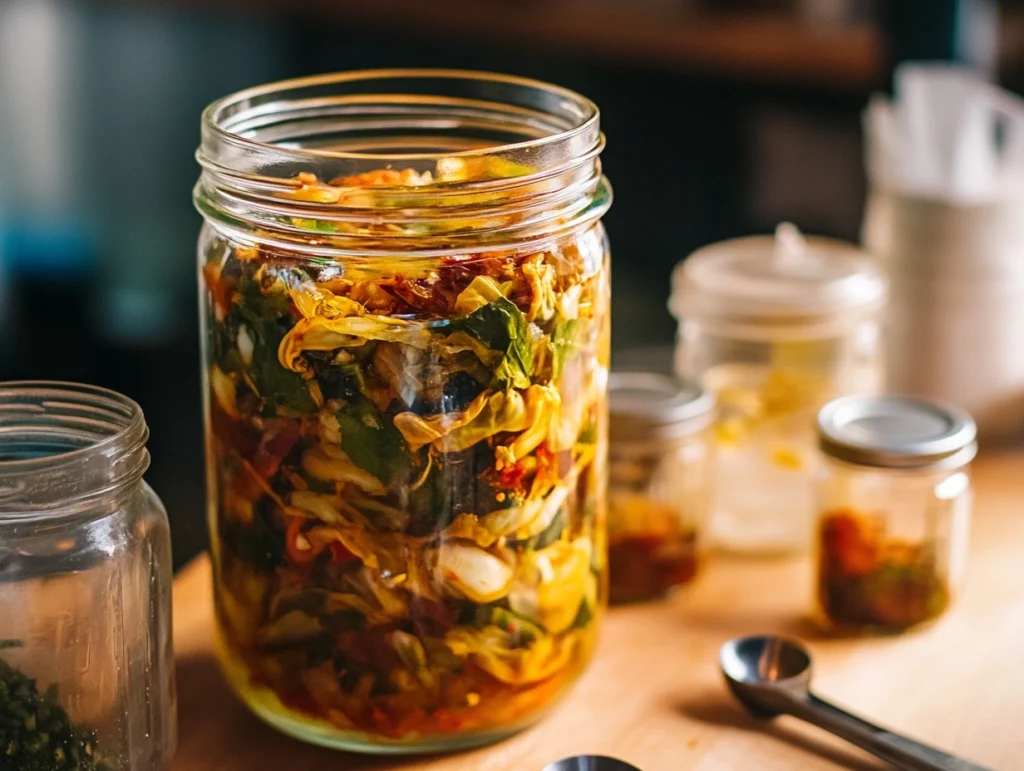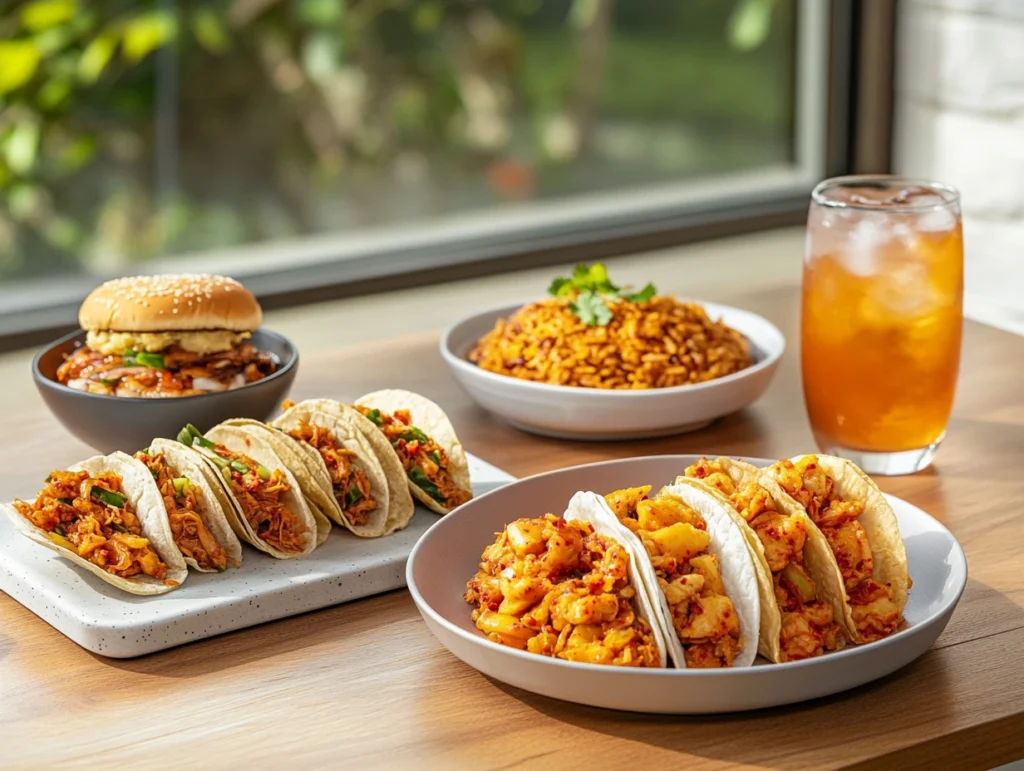Kimchi, a key part of Korean food, is more than just a side dish. This tangy, spicy, and flavorful fermented vegetable dish has won the hearts of food lovers worldwide. Whether you’ve been enjoying kimchi for years or are tasting it for the first time, this article dives into what makes it special. From its basic ingredients to the fermentation process, you’ll uncover the secrets of this tasty dish. Let’s begin by exploring kimchi’s history and cultural value.
Introduction to Kimchi
Definition of Kimchi
Kimchi is a fermented vegetable dish from Korea, loved for its bold flavors and versatility. It’s usually made with napa cabbage or Korean radish, seasoned with garlic, ginger, and chili powder for its signature taste. What sets kimchi apart is its tangy flavor, created through fermentation. This process transforms simple vegetables into a healthy, probiotic-rich food.
Cultural Significance in Korea
In Korea, it is more than a dish—it’s a tradition and symbol of togetherness. Kimjang, the seasonal act of making kimchi, brings families and communities together as they prepare large batches for winter. This practice reflects Korea’s resilience and pride. Today, UNESCO recognizes kimjang as a part of the world’s Intangible Cultural Heritage.
Why Kimchi is Popular Globally
This recipe has become famous around the world for good reason. Its probiotics, rich nutrients, and bold umami flavor appeal to health-conscious eaters and adventurous foodies alike. Plus, it’s so versatile—it pairs well with rice, tacos, soups, and even sandwiches. Whether you’re boosting your gut health or adding flavor to your meals, kimchi is worth trying.
Primary Ingredients of Kimchis
Napa Cabbage and Korean Radish
The base of most kimchi recipes is made up of napa cabbage and Korean radish. These vegetables bring the crunch and soak up the rich seasoning mix, creating a perfect blend of textures and flavors. Napa cabbage, with its soft but sturdy leaves, is the top choice for traditional baechu kimchi. On the other hand, Korean radish, with its mild sweetness and firm bite, is key in dishes like kkakdugi (cubed radish kimchi). Picking fresh, high-quality vegetables is essential to achieving the best flavor.

Essential Seasonings: Garlic, Ginger, and Chili Powder
No exploration of what kimchi is made of would be complete without mentioning its bold seasonings. Garlic and ginger, finely minced or pureed, give depth and warmth to the dish. The iconic gochugaru (Korean chili powder) adds the signature red color and smoky spice. The quality and amount of chili powder you use significantly affect the final taste and heat level.
Salt and Fermentation Basics
Salt is the secret weapon in the kimchi-making process. It helps draw out moisture from the vegetables and kick-starts fermentation by creating an environment ideal for lactic acid bacteria. This step not only preserves the vegetables but also develops the tangy flavor kimchi is famous for. However, it’s important to balance the amount of salt—too much can overwhelm the taste, while too little might prevent proper fermentation.
Variations of Kimchi Recipes
Traditional Baechu Kimchi
When people ask, “What is kimchi made of?”, traditional baechu kimchi is usually the answer. This classic recipe involves napa cabbage leaves slathered in a savory, spicy paste made from gochugaru, garlic, ginger, and fish sauce. It’s a staple on Korean tables and sets the standard for fermented dishes.
Non-Cabbage Variants: Cucumber and Radish
This recipe isn’t all about cabbage. Oi sobagi (stuffed cucumber kimchi) is a crisp and refreshing choice for summer, blending the crunch of cucumbers with traditional spices. Kkakdugi (cubed radish kimchi) highlights Korean radish, seasoned for a heartier, tangy flavor.
Modern Twists: Vegan and Gluten-Free Options
It has evolved to meet diverse dietary needs. Vegan versions replace fish sauce with options like soy sauce or kelp powder, keeping the umami flavor without animal products. Gluten-free versions skip rice paste, making this nice recipe more accessible without losing its authentic taste.
The Science of Fermentation
Role of Lactic Acid Bacteria in Fermentation
The fermentation process is the heartbeat of kimchi. Beneficial lactic acid bacteria naturally present in the vegetables and environment transform the raw ingredients into the tangy, flavorful kind of recipe we love. These bacteria thrive in the salty brine created during preparation, producing lactic acid, which gives our recipe its distinctive sourness. This process also extends kimchi’s shelf life by inhibiting harmful bacteria.

Health Benefits of Probiotics in Kimchi
This recipe isn’t just delicious; it’s a probiotic powerhouse. The fermentation fosters a rich community of gut-friendly bacteria, which can improve digestion, enhance immunity, and even boost mental health. Studies suggest regular consumption of fermented foods like our recipemay contribute to a balanced gut microbiome, a cornerstone of overall well-being. If you’ve ever wondered what is kimchi made of that gives it such health benefits, the answer lies in its living, active cultures.
Balancing Flavor Profiles During Fermentation
Perfecting the flavor of kimchi is part science, part art. Temperature and time significantly affect the fermentation process. Warmer temperatures speed up fermentation, resulting in a stronger tang, while cooler environments slow it down for a milder taste. Taste-testing throughout ensures the balance of sour, salty, and umami flavors is just right.
For more insights into preserving traditional flavors, check out our other articles on homemade fermentation recipes.
Making This recipe at Home
Step-by-Step Process
Making this recipeat home is easier than you think! Begin by salting napa cabbage to draw out moisture and soften its texture. Next, prepare a paste using gochugaru, garlic, ginger, fish sauce (or a vegan alternative), and optional rice paste for thickness. Coat each cabbage leaf generously with this flavorful mixture, ensuring even coverage.
Pack the seasoned cabbage tightly into an airtight container or jar, leaving space for gases to escape during fermentation. Store it at room temperature for 1-2 days before transferring it to the refrigerator to slow the process.
Key Tips for Perfect Fermentation
Consistency is key when fermenting that recipe. Use the freshest ingredients for the best results and sterilize jars to avoid contamination. Monitor your fine recipedaily, and remember that the flavor evolves over time—taste-testing is encouraged! For an extra punch, try adding sliced pear or apple to the paste for natural sweetness.
Common Mistakes to Avoid
Avoid using iodized salt, as it can interfere with fermentation. Similarly, overpacking jars can cause leaks, while under-salting leads to insufficient preservation. Be patient—this lovely recipe develops its best flavors with time.
If you’re interested in other ways to explore fermented foods, our site offers a variety of creative recipes, such as easy homemade brine dishes.
FAQs About Kimch
Can Kimchi recipe Be Made Without Spices?
Absolutely! While traditional kimchi is known for its spicy kick, there are mild versions too. White kimchi, or baek kimchi, skips the chili powder and focuses on savory and slightly sweet flavors. This type uses napa cabbage, radish, garlic, and ginger but offers a gentler taste. It’s great for anyone who prefers a non-spicy option while still enjoying the essence of fermented vegetables. What is kimchi made of in this case? The same base ingredients, just without the heat.
How Long Does Kimchi Last?
This delicious recipe is a living, changing dish. At room temperature, it ferments quickly and should be eaten within a few days. In the fridge, it can last several weeks or even months, depending on how sour you like it. Over time, the flavors get stronger and richer. Don’t throw out overly fermented kimchi—it’s perfect for dishes like stews or fried rice, where its bold, tangy flavor shines.
What Are the Different Ways to Eat Kimchi?
This recipe is super versatile. Enjoy it as a side dish, with rice, or in soups and stews like kimchi jjigae. It’s also a tasty topping for tacos, burgers, or sandwiches. For something fun, mix it into scrambled eggs or add it to savory pancakes for extra flavor.

Conclusion and Final Thoughts
Why Everyone Should Try Making Kimchi
Kimchi isn’t just food—it’s an experience that connects you to Korean culture and traditions. By learning what kimchi is made of and trying different ingredients, you can make your unique version of this classic dish. Plus, its probiotics offer great health benefits, making it a valuable addition to your meals.
A Dish That Embodies Culture and Flavor
Kimchi’s flavors—spicy, tangy, savory, and sweet—are a perfect mix of simple ingredients and traditional methods. Whether you eat it fresh or fully fermented, as a side or a recipe ingredient, kimchi always delivers. Its global popularity proves this fermented gem belongs on tables everywhere.
Want to explore more recipes? Check out our library for creative ideas and fermentation tips!
Creative Uses for Kimmchi
This recipe in Fusion Cuisine
This dish has moved beyond its traditional roots to become a global culinary favorite, especially in fusion recipes. From kimchi tacos to kimchi-topped pizza, this spicy, fermented vegetable adds a surprising zing to familiar dishes. Its tangy and savory flavors pair beautifully with cheese, meats, and even pasta, creating bold and creative combinations. Next time you’re cooking, think outside the box and experiment—what is kimchi made of might inspire endless ideas for your kitchen.
Kimchi in Comfort Foods
For cozy, comforting meals, kimchi shines in recipes like fried rice or grilled cheese sandwiches. Adding a spoonful to ramen or stew completely transforms the flavor, adding depth and complexity. Even breakfast favorites like scrambled eggs or avocado toast can get a flavorful boost with a dollop of kimchi for a spicy twist. With its incredible versatility, there’s no end to how you can enjoy this beloved recipe in your meals.
Kimchi Around the World
Kimchi’s Global Impact
Kimchi’s popularity isn’t limited to Korea—it’s celebrated worldwide. As more people embrace fermentation and bold flavors, Our recipe has found its way into grocery stores, gourmet menus, and home kitchens across the globe. In countries like Japan, China, and the United States, it has inspired localized versions, each adding a unique twist while staying true to its origins. Curious about what is kimchi made of in different regions? Some adaptations incorporate local vegetables and spices for a personalized touch.
Kimchi Festivals and Cultural Exchange
Did you know there are festivals dedicated to kimchi? Events like the Gwangju Kimchi Festival in South Korea celebrate this beloved dish, drawing visitors from all over the world. These gatherings not only highlight traditional techniques but also foster cultural exchange, showing how food can bring people together. Attending a festival or exploring local kimchi variations is an excellent way to deepen your appreciation for this iconic dish.
